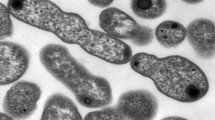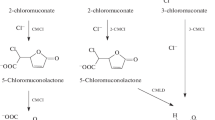Abstract
A halobenzene-degrading bacterium, Burkholderia fungorum FLU100 (DSM 23736), was isolated due to its outstanding trait to degrade fluorobenzene. Besides fluorobenzene, it utilizes, even in random mixtures, chlorobenzene, bromobenzene, iodobenzene, benzene, and toluene as sole sources of carbon and energy. FLU100 mineralizes mono-halogenated benzenes almost stoichiometrically (according to halide balance); after a lag phase, it also degrades 3-fluorophenol and 3-chlorophenol completely. The FLU100-derived transposon Tn5-mutant FLU100-P14R22 revealed 3-halocatechol to be a central metabolite of this new halobenzene degradation pathway. In FLU100, halocatechols are—as expected—strictly subject to ortho-cleavage of the catechol ring, with meta-cleavage never been observed. The strain is able to completely mineralize 3-fluorocatechol, the principal catecholic metabolite being nearly exclusively formed from fluorobenzene. The temporarily excreted 2-fluoromuconate formed thereof in turn is subsequently metabolized completely. This important finding falsifies the customary opinion of the persistence of 2-fluoromuconate valid up to now. The degradation of 4-fluorocatechol, however, being a very minor intermediate in FLU100, is substantially slower and incomplete and leads to the accumulation of uncharacterized derivatives of muconic acid and muconolactone in the medium. This branch therefore does not seem to be productive. To our knowledge, this represents the first example of the complete metabolism of 3-fluorocatechol via 2-fluoromuconate, a metabolite hitherto described as a dead-end metabolite in fluoroaromatic degradation.




Similar content being viewed by others
References
Bartels I, Knackmus HJ, Reineke W (1984) Suicide inactivation of catechol 2,3-dioxygenase from Pseudomonas putida mt-2 by 3-halocatechols. Appl Environ Microbiol 47:500–505
Beil S, Happe B, Timmis KN, Pieper DH (1997) Genetic and biochemical characterization of the broad spectrum chlorobenzene dioxygenase from Burkholderia sp. strain PS12—dechlorination of 1,2,4,5-tetrachlorobenzene. Eur J Biochem 247:190–199
Broderick JB, O’Halloran TV (1991) Overproduction, purification, and characterization of chlorocatechol dioxygenase, a non-heme iron dioxygenase with broad substrate tolerance. Biochem J 30:7349–7358
Carvalho MF, Alves CCT, Ferreira MIM, De Marco P, Castro PML (2002) Isolation and initial characterization of a bacterial consortium able to mineralize fluorobenzene. Appl Environ Microbiol 68:102–105
Carvalho MF, Ferreira Jorge R, Pacheco CC, De Marco P, Castro PML (2005) Isolation and properties of a pure bacterial strain capable of fluorobenzene degradation as sole carbon and energy source. Environ Microbiol 7:294–298
Carvalho MF, Ferreira Jorge R, Pacheco CC, De Marco P, Henriques IS Correia A, Castro PML (2006) Long-term performance and microbial dynamics of an up-flow fixed bed reactor established for the biodegradation of fluorobenzene. Appl Microbiol Biotechnol 71:555–562
Carvalho MF, De Marco P, Duque AF, Pacheco CC, Janssen DB, Castro PML (2008) Labrys portucalensis sp nov., a fluorobenzene-degrading bacterium isolated from an industrially contaminated sediment in northern Portugal. Int J Syst Evol Microbiol 58:692–698
Dorn E, Knackmuss HJ (1978) Chemical structure and biodegradability of halogenated aromatic compounds—substituent effects on 1,2-dioxygenation of catechol. J Biochem 174:85–94
Engesser KH, Schulte P (1989) Degradation of 2-bromobenzoate, 2-chlorobenzoate and 2-fluorobenzoate by Pseudomonas putida CLB 250. FEMS Microbiol Lett 60:143–148
Engesser KH, Schmidt E, Knackmuss HJ (1980) Adaptation of Alcaligenes eutrophus B9 and Pseudomonas sp. B-13 to 2-fluorobenzoate as growth substrate. Appl Microbiol Biotechnol 39:68–73
Engesser KH, Auling G, Busse J, Knackmuss HJ (1990) 3-Fluorobenzoate enriched bacterial strain FLB 300 degrades benzoate and all 3 isomeric monofluorobenzoates. Arch Microbiol 153:193–199
Fogel MM, Taddeo AR, Fogel S (1986) Biodegradation of chlorinates ethenes by a methane-utilizing mixed culture. Appl Environ Microbiol 51:720–724
Harper DB, Blakley ER (1971) The metabolism of p-fluorobenzoic acid by a Pseudomonas sp. Can J Microbiol 17:1015–1023
Kaschabek SR, Reineke W (1992) Maleylacetate reductase of Pseudomonas sp. strain B13: dechlorination of chloromaleylacetates, metabolites in the degradation of chloroaromatic compounds. Arch Microbiol 158:412–417
Kaschabek SR, Kasberg T, Muller D, Mars AE, Jannsen DB, Reinecke W (1998) Degradation of chloroaromatics: purification and characterization of a novel type of chlorocatechol 2,3-dioxygenase of Pseudomonas putida GJ31. J Bacteriol 180:296–302
Lane DJ (1991) 16S/23S rRNA sequencing. In: Stackebrandt E, Goodfellow M (eds) Nucleic acid techniques in bacterial systematics. Wiley, Chichester, pp 115–175
Mars AE, Kasberg T, van Agteren MH, Jannsen DB, Reinecke W (1997) Microbial degradation of chloroaromatics: use of the meta-cleavage pathway for mineralization of chlorobenzene. J Bacteriol 179:4530–4537
Onaca C, Kieninger M, Engesser KH, Altenbuchner J (2007) Degradation of alkyl methyl ketones by Pseudomonas veronii MEK700. J Bacteriol 189:3759–3767
Pfennig N, Lippert KD (1966) Über das vitamin B12—Bedürfnis phototropher Schwefelbakterien. Arch Mikrobiol 55:245–256
Raschke H, Fleischmann T, van der Meer JR, Kohler HPE (1999) cis-Chlorobenzene dihydrodiol dehydrogenase (TcbB) from Pseudomonas sp. strain P51, expressed in Escherichia coli DH5(pTCB149), catalyzes enantioselective dehydrogenase reactions. Appl Environ Microbiol 65:5242–5246
Reineke W, Knackmuss HJ (1984) Microbial metabolism of haloaromatics: isolation and properties of a chlorobenzene-degrading bacterium. Appl Environ Microbiol 47:395–402
Sala-Trepat JM, Evans WC (1971) The meta cleavage of catechol by Azotobacter species (4-oxalocrotonate pathway). Eur J Biochem 20:400–413
Schlömann M (1994) Evolution of chlorocatechol catabolic pathways. Biodegradation 5:301–321
Schlömann M, Fischer P, Schmidt E, Knackmuss HJ (1990a) Enzymatic formation, stability, and spontaneous reactions of 4-fluoromuconolactone, a metabolite of the bacterial degradation of 4-fluorobenzoate. J Bacteriol 172:5119–5129
Schlömann M, Schmidt E, Knackmuss HJ (1990b) Different types of dienelactone hydrolase in 4-fluorobenzoate utilizing bacteria. J Bacteriol 172:5112–5118
Schmidt E, Knackmus KH (1980) Chemical structure and biodegradability of halogenated aromatic compounds. Conversion of chlorinated muconic acids into maleoylacetic acid. J Biochem 192:339–347
Schmidt E, Knackmuss KH (1984) Production of cis,cis-muconate from benzoate and 2-fluoro-cis,cis-muconate from 3-fluorobenzoate by 3-chlorobenzoate degrading bacteria. Appl Microbiol Biotechnol 20:351–355
Schreiber A, Hellwig M, Dorn E, Reineke W, Knackmuss KH (1980) Critical reactions in fluorobenzoic acid degradation by Pseudomonas sp. B13. Appl Environ Microbiol 39:58–67
Solyanikova IP, Moiseeva OV, Boeren S, Boersma MG, Kolomytseva MP, Vervoort J, Rietjens IMCM, Golovleva LA, van Berkel WJH (2003) Conversion of 2-fluoromuconate to cis-dienelactone by purified enzymes of Rhodococcus opacus 1cp. Appl Environ Microbiol 69:5636–5642
Strunk N (2008) The degradation of fluorobenzene by Burkholderia fungorum FLU100. Dissertation, University of Stuttgart, Germany. http://elib.uni-stuttgart.de/opus/volltexte/2008/3640/pdf/Dissertation_Niko_Strunk.pdf
Tiedje JM, Duxbury JM, Alexander M, Dawson JE (1969) 2,4-D metabolism: pathway of degradation of chlorocatechols by Arthrobacter sp. J Agric Food Chem 17:1021–1026
Werlen C, Kohler HPE, van der Meer JR (1996) The broad substrate chlorobenzene dioxygenase and cis-chlorobenzene dihydrodiol dehydrogenase of Pseudomonas sp. strain P51 are linked evolutionarily to the enzymes for benzene and toluene degradation. J Biol Chem 271:4009–4016
Acknowledgments
We dedicate this paper to Prof. Dr. H.-J. Knackmuss, whose tutoring and friendship for so many years is responsible for one of us having spent his adult scientific life in the microbiology of degradative processes and whose work has inspired both of us. We thank the Deutsche Forschungsgemeinschaft DFG for funding the project “Halo- and Alkylbenzene degrading Bacteria—their characterization and use in environmental protection processes” (EN 474/2-2). We also thank G. Auling for precious information on the industrial biotrickling filter.
Author information
Authors and Affiliations
Corresponding author
Rights and permissions
About this article
Cite this article
Strunk, N., Engesser, KH. Degradation of fluorobenzene and its central metabolites 3-fluorocatechol and 2-fluoromuconate by Burkholderia fungorum FLU100. Appl Microbiol Biotechnol 97, 5605–5614 (2013). https://doi.org/10.1007/s00253-012-4388-2
Received:
Revised:
Accepted:
Published:
Issue Date:
DOI: https://doi.org/10.1007/s00253-012-4388-2




